-
Car Reviews
- All reviews
- Midsize SUVs
- Small cars
- Utes
- Small SUVs
- Large SUVs
- Large cars
- Sports SUVs
- Sports cars
- Vans
Latest reviews
- Car News
-
Car Comparisons
Latest comparisons
- Chasing Deals
Beneath its concept car-like aesthetics, the now-electric Renault Megane is a sophisticated compact crossover – albeit with a few flaws and omissions
Before you even start to consider whether the Renault Megane E-Tech is a good electric car comes a more elementary thought: it’s a really good looking vehicle.
Tight proportions, a surprisingly compact body and just the right amount of concept car-esque futurism combine to make the first all-electric Megane a compelling sight.
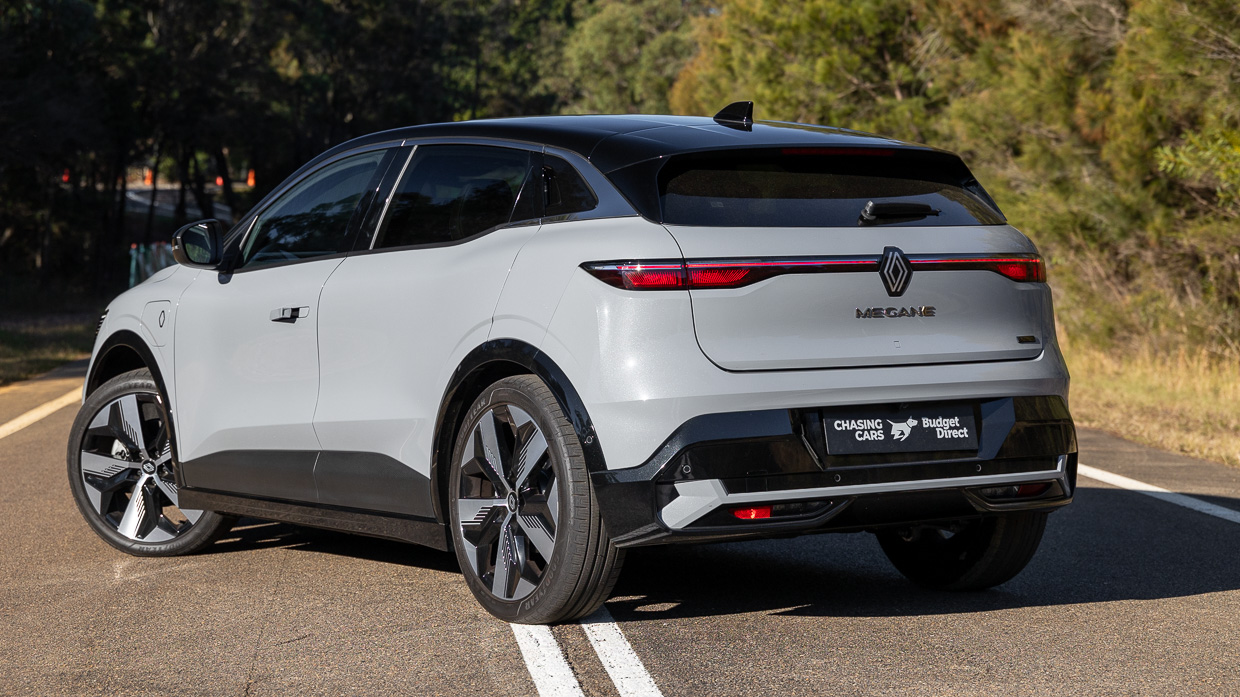
On sale for a couple of years already in Europe, the Megane E-Tech launched in Australia earlier in 2024 with just one specification.
Our market’s EV60 Techno variant is effectively a mid-specification version of what can be purchased in the United Kingdom. We get many of the important features – including the larger of two available batteries – but some creature comforts are missing, even from the options list.
That was a big problem when pricing was originally announced for the Megane E-Tech, which was to retail for about $70,000 driveaway at launch in most Australian states. But before the cars even hit local roads, Renault importer Ateco had slashed the on-road price to $60,000.
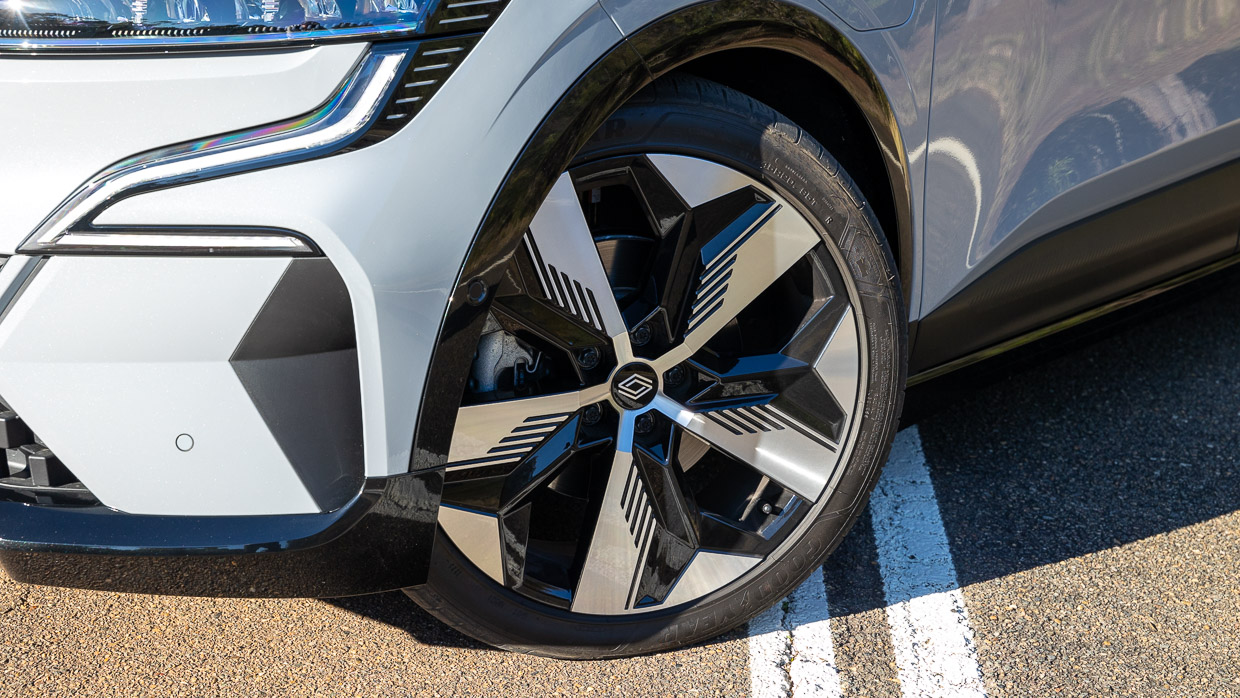
Technically a limited-time offer due to expire on the very day we tested the E-Tech (30 June 2024), the discounted price point is far closer to what the electric Renault is worth, particularly given this car is (perhaps surprisingly) smaller than a Volkswagen Golf.
It might look like a small to midsize SUV in photos, partially because of the tremendously successful visual effect of the Techno’s 20-inch alloy wheels, pushed right to the corners of the Megane’s dedicated CMF-EV electric car platform.
But it is actually very petite in dimensions at just 4200mm long, 1768mm wide and 1500mm high.
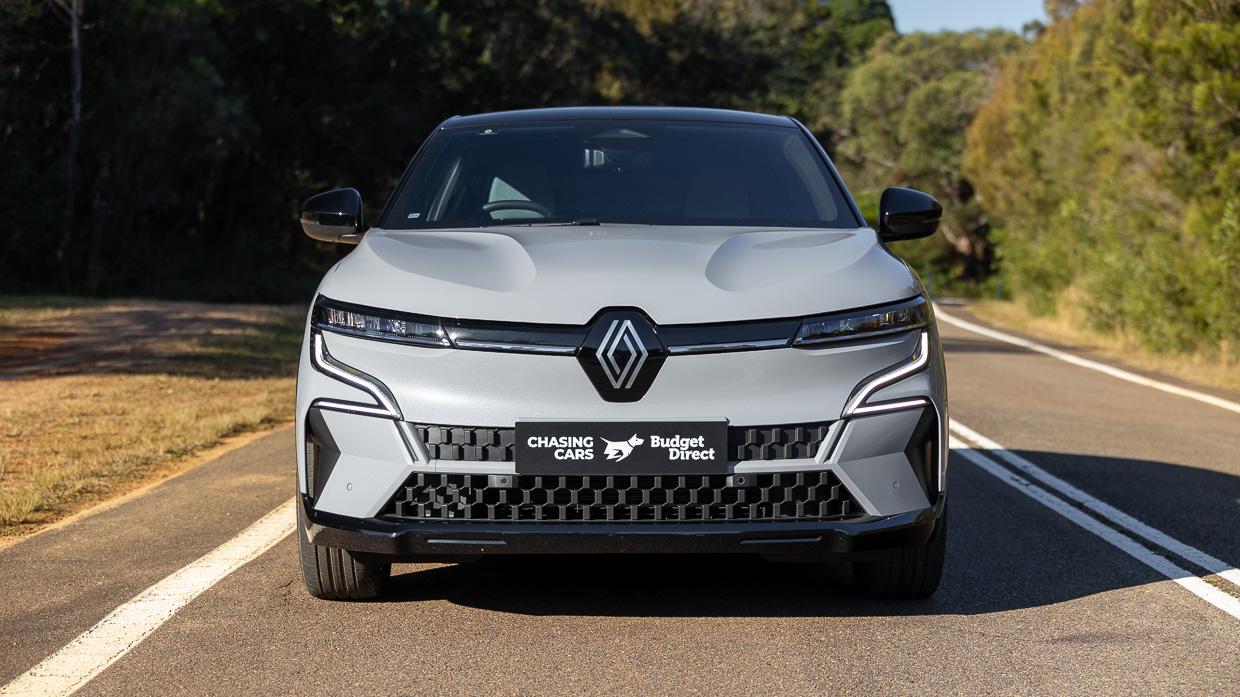
While the sharpened deal was set to expire at the end of the financial year, Renault Australia continues to advertise the $60K-driveaway through July, at the time of publication.
But with plenty of other EVs either experiencing price cuts (Tesla Model 3, Tesla Model Y) or joining the fray at increasingly reasonable price points (Volvo EX30), does the Renault Megane E-Tech continue to represent good buying in Australia?
Or is this a niche electric vehicle best considered only by Renault faithful?
At its onging promotional price, the Megane E-Tech represents reasonable though not exceptional value for money.
The final price is dependent only on exterior colour, with the most affordable specification – in one-tone Solid White non-metallic paint – available at $59,959 driveaway in New South Wales before negotiation.
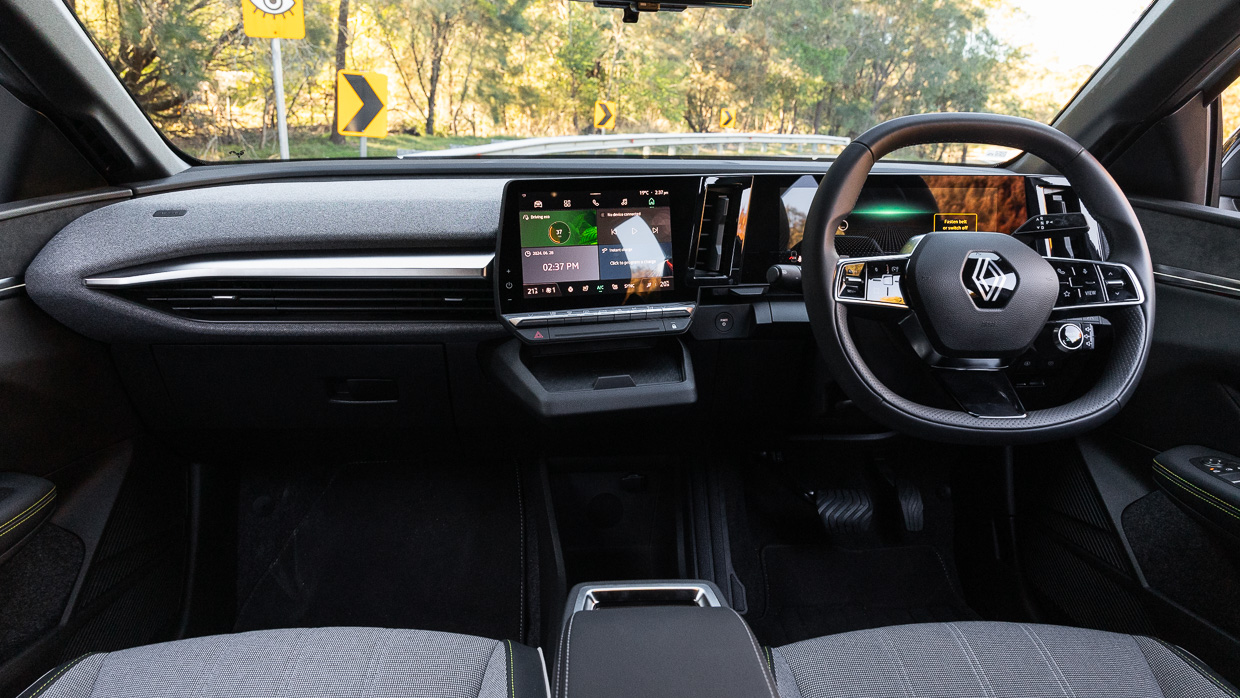
For that price, the Megane E-Tech includes the following standard features:
Safety technology is covered off beneath the separate “Is the Megane E-Tech a safe car?” section.
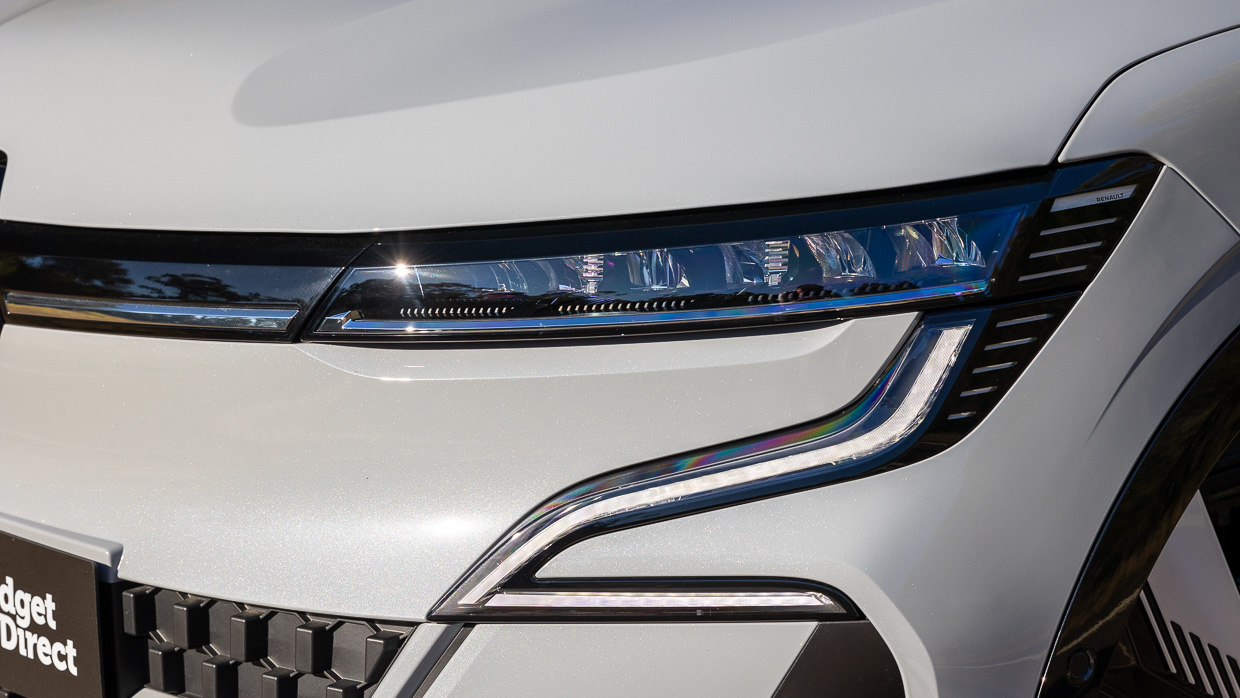
The only options relate to exterior paint. The following choices outside of no-cost solid white are available:
Our tester was delivered in the communications specification of Rafale Grey with a Diamond Black roof, attracting the full $800 premium, for a delivered on-road price of $60,789.
There are a number of features missing from the Australian-spec Techno that are fitted to the equivalent variant in the UK, including a larger 12-inch touchscreen running the Google Android Automotive system, navigation, and connected services with a vehicle app and over-the-air updates.
The Brits can get a higher trim, called the Iconic, which adds features not offered here including a 360-degree parking camera and semi-autonomous parking. There’s a cheaper (UK) model, too, called Evolution, with smaller 18-inch wheels and the Aussie-spec Open R infotainment system.
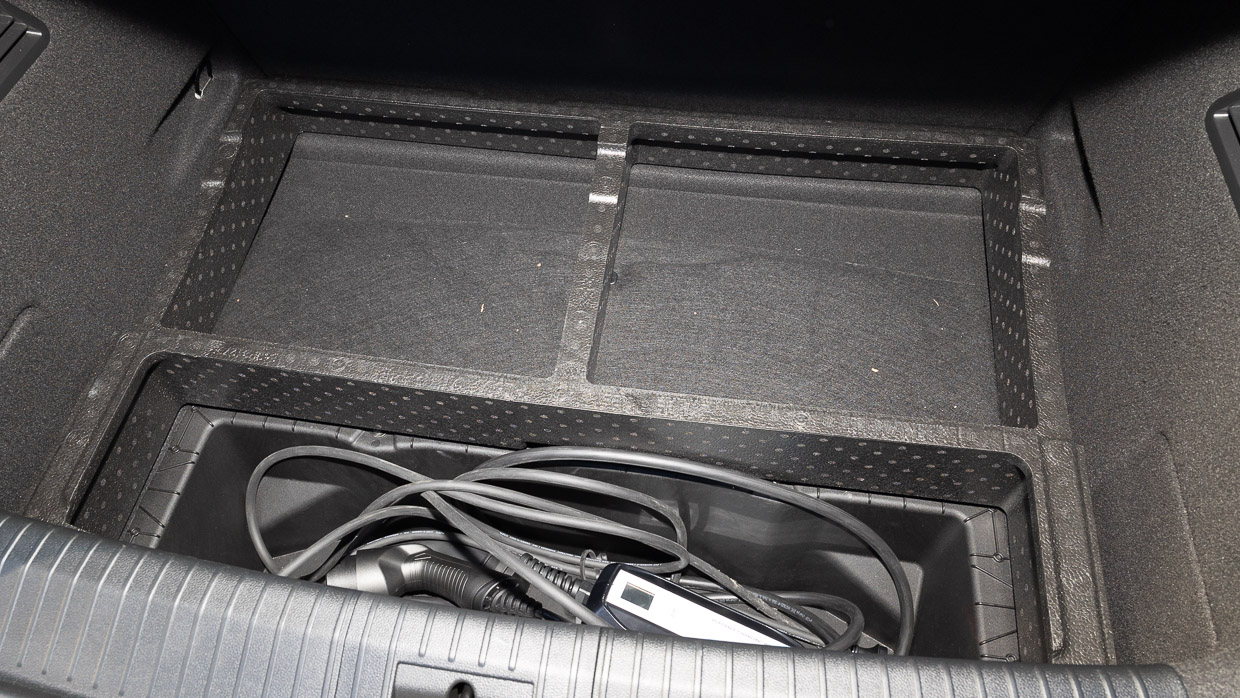
While the global lack of a power tailgate or panoramic glass roof will bug some, it’s genuinely disappointing that Australians miss out on the Megane E-Tech app, connectivity, and more modern infotainment.
In fact, Renault Australia dips into the global base model’s cheaper software for our market’s effective mid-spec car.
We’d like to see those features added, as they are firmly becoming an expectation, even below the $60,000 price point.
Buyers already faithful to the established Renault school of perky, powerful front-wheel-drive hot hatches will be right at home in a Megane E-Tech, which appears to have been developed according to the same ethos as great Clios and Meganes of days gone by.
Sure, it’s a little heavier than a featherweight hatchback, but with a tare weight of 1642kg, it is easily one of the lightest EVs on sale in Australia. It’s 119kg under a base Tesla Model 3 and more than 300kg lighter than a Cupra Born. Renault has done a great job keeping the kilos off.
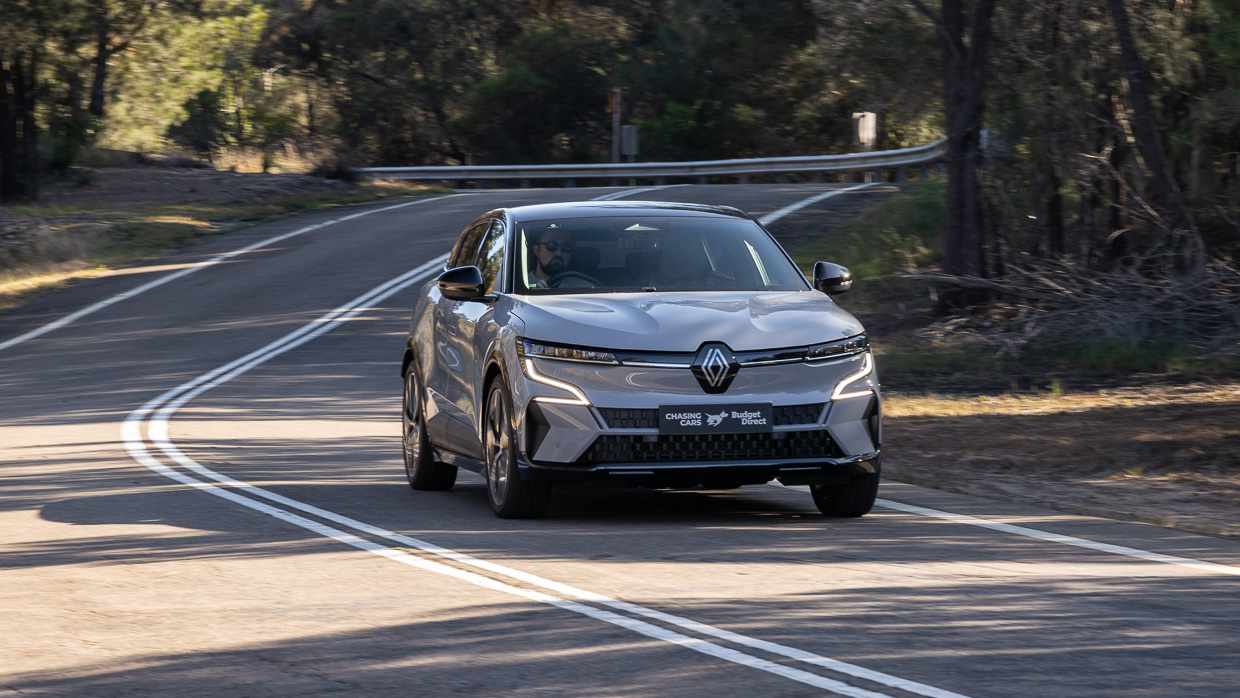
The discipline to keeping the core vehicle nearly as light as possible (it is 1248kg without the 394kg battery pack) has created a really enjoyable vehicle to drive on the right road.
The Megane’s dynamics are not without fault, but the issues that do arise are mainly down to specification, rather than any intrinsic lack of ability.
Like the Clios and Meganes we remember (perhaps through rose-tinted glasses), the E-Tech is front-wheel drive, highly responsive, lightweight (in a relative sense), and appreciably stiff.
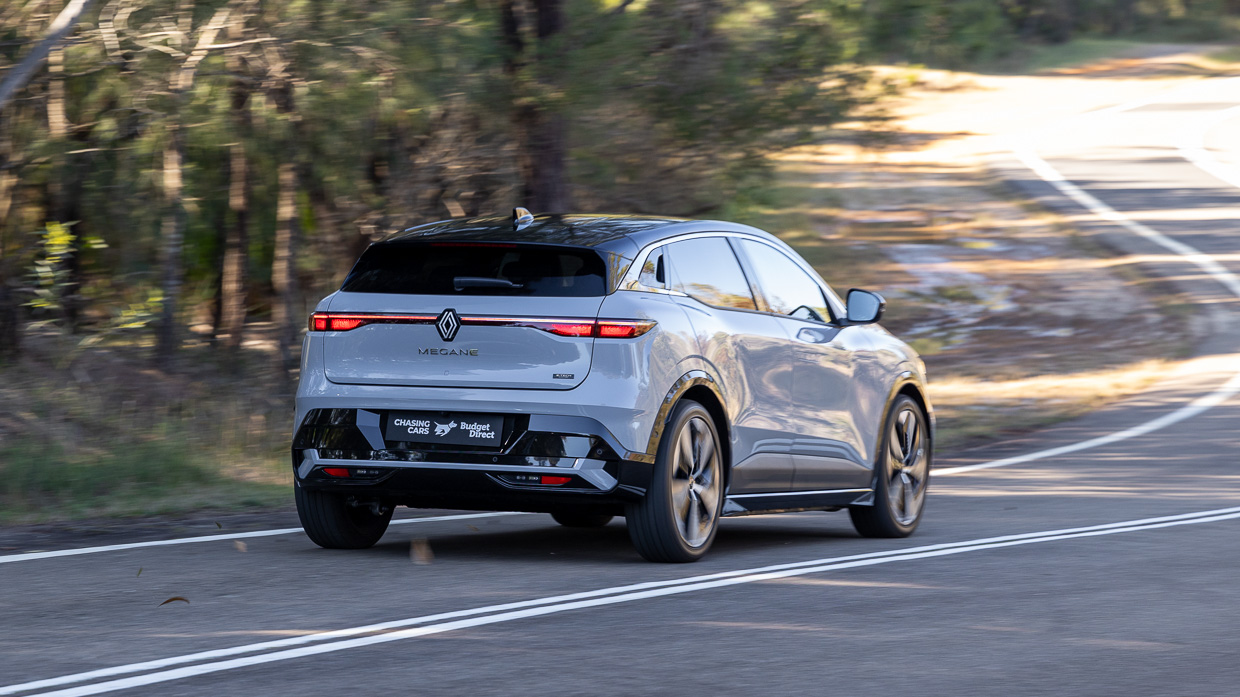
Those characteristics combine to make this electric Renault an interesting and multi-dimensional driver’s car, for those keen to exploit its dynamics.
But there are quite a few $40K-$65K EVs to which that description now applies – the MG4 and Cupra Born come rapidly to mind – and those vehicles are rear-wheel drive. Renault has bucked the trend to opt for RWD popularised by EV simplification: instead, the Megane’s platform is natively front-wheel drive.
Named CMF-EV/AmpR Medium, the Renault sits on a dedicated electric car architecture shared with two midsize SUVs: the size-up Renault Scenic E-Tech (under study for Australia) and the Nissan Ariya (delayed, time and again, for our market).
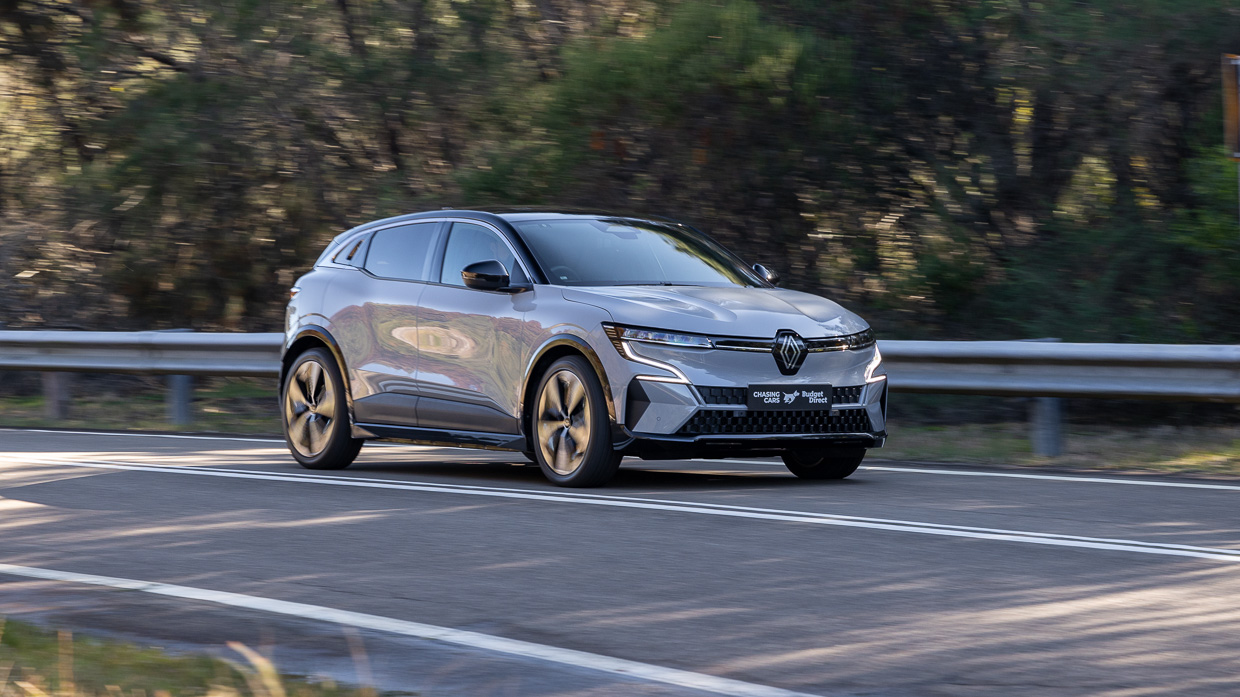
The AmpR chassis situates a powerful motor at the front, though it is capable of all-wheel drive by adding a less potent, second motor at the rear.
Still, there is no AWD version of the Megane E-Tech offered anywhere globally, so this small car is limited to 2WD.
That is, if anything, beneficial: the front-drive nature of the Renault aids efficiency because inertia under (adjustable) regenerative braking applies more force to the front axle. But drivers have to live with the compromises of front-wheel drive.
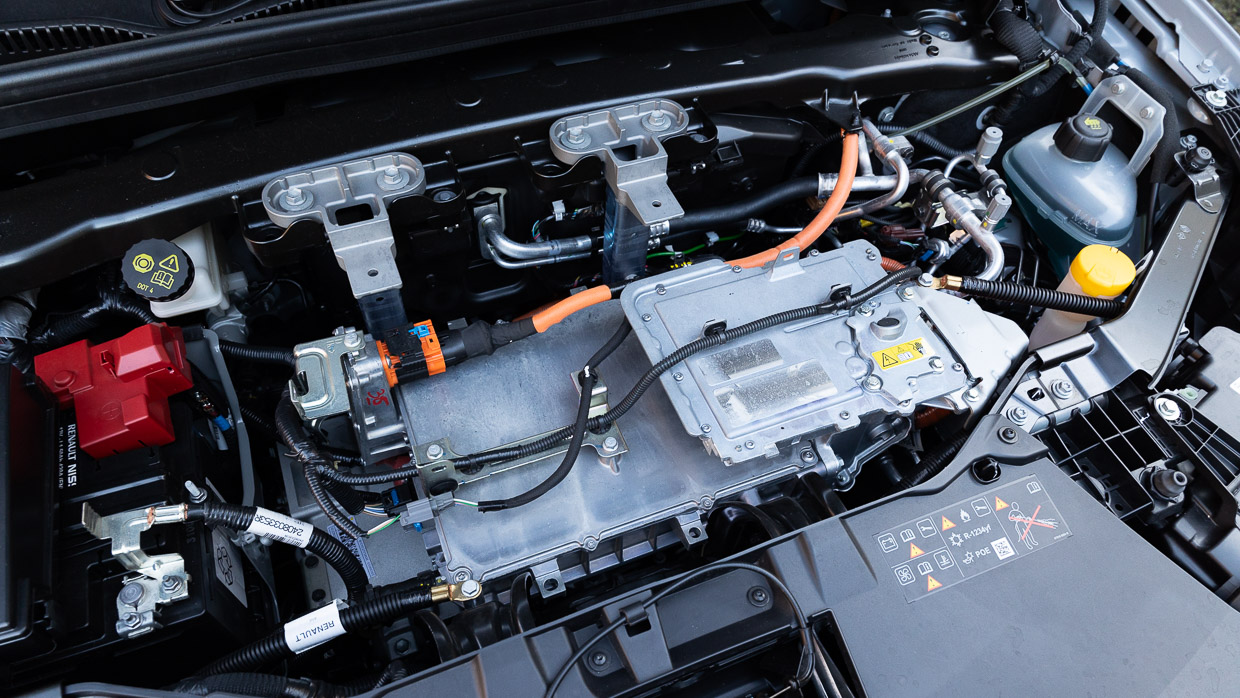
Australia only gets the most powerful Megane E-Tech: the single motor generates 160kW of power and 300Nm, and gets it to the road via the aforementioned front axle with a single-speed reduction gear.
Performance is perky. The instant torque and the Sport mode’s sharp throttle response saw us nab a 0-100km/h time of 6.99 seconds, comfortably swifter than the 7.4sec claim.
The rolling acceleration – say from 40km/h to 70km/h – is really impressive, with a zesty immediacy of response followed by a lush wave of power. But with so much on tap, it’s relatively easy to overwhelm the adhesion of the tall – but narrow – 215/45 R20 Goodyear EfficientGrip tyres.
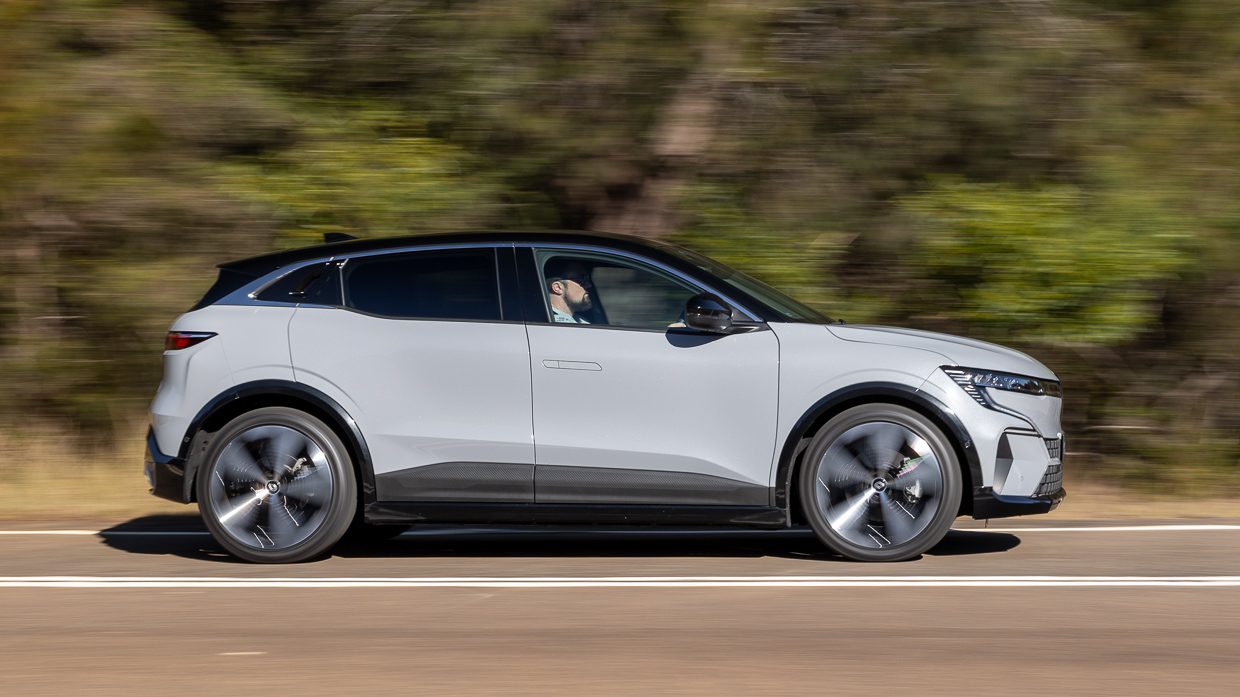
Plant the boot on a greasy road, particularly when driving out of a corner, and you quickly feel the inside front tyre spinning up while the traction control light blinks.
Narrow tyres aren’t that unusual in this part of the EV market, especially as reducing the contact patch does increase efficiency (at the expense of grip). But you can ultimately push an MG4 or a Cupra Born harder as the driven wheels are at the rear, leaving the fronts to do the turning alone.
When the road dries out and grip improves, though, you can really lean on the Megane’s chassis. The steering is sweet and true, with an intuitive ratio, and the stiff, rigid chassis is more than up for a spirited drive. We would not be surprised if Renault chooses to develop a proper ‘RS’ version of the E-Tech, as the platform feels capable of even higher performance.
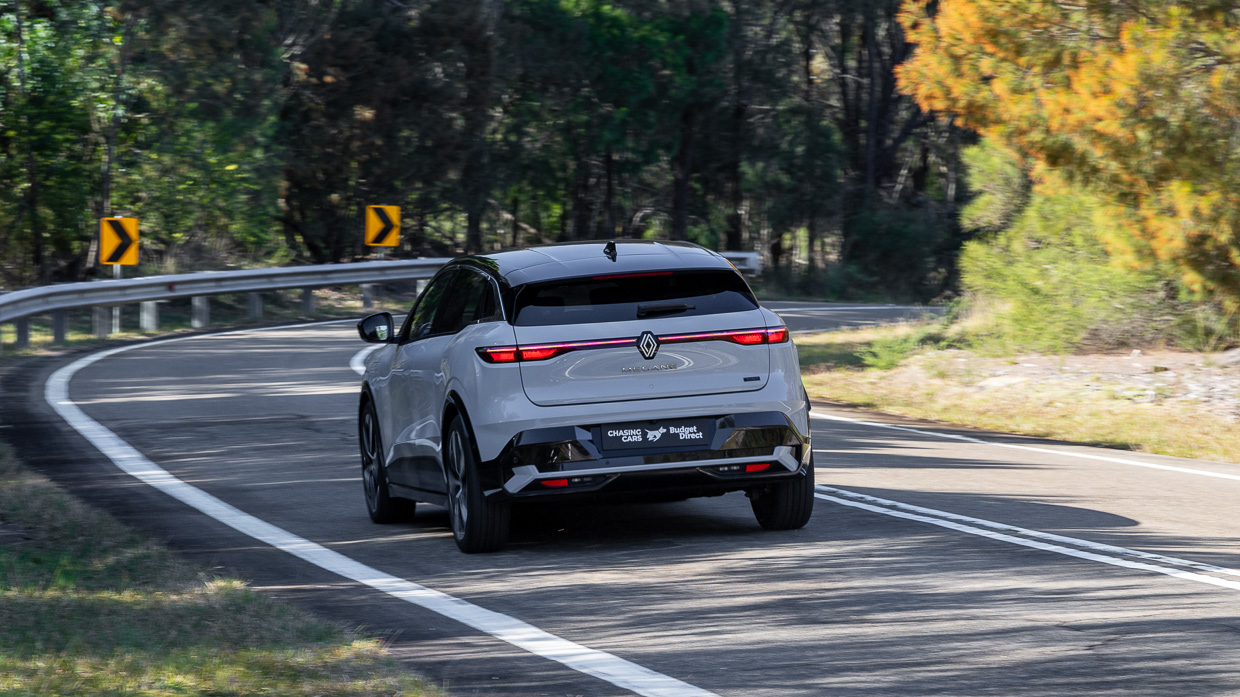
There is certainly room for improvement in brake feel, though. The regenerative braking has three selectable stages, variable via the wheel-mounted paddle shifters.
But even the strongest mode isn’t one-pedal driving, leaving drivers to regularly need to engage the brakes to bring the Megane to a stop. That means you regularly encounter a wooden-feeling pedal with rough blending of the regen’ and the friction brake.
The ride, too, needs work. The Renault is actually damped pretty nicely – there is nice absorption of undulations and a pleasant gait to the chassis as the road surface gently changes. But there is a limit to what sort of surface hits the Renault can take.
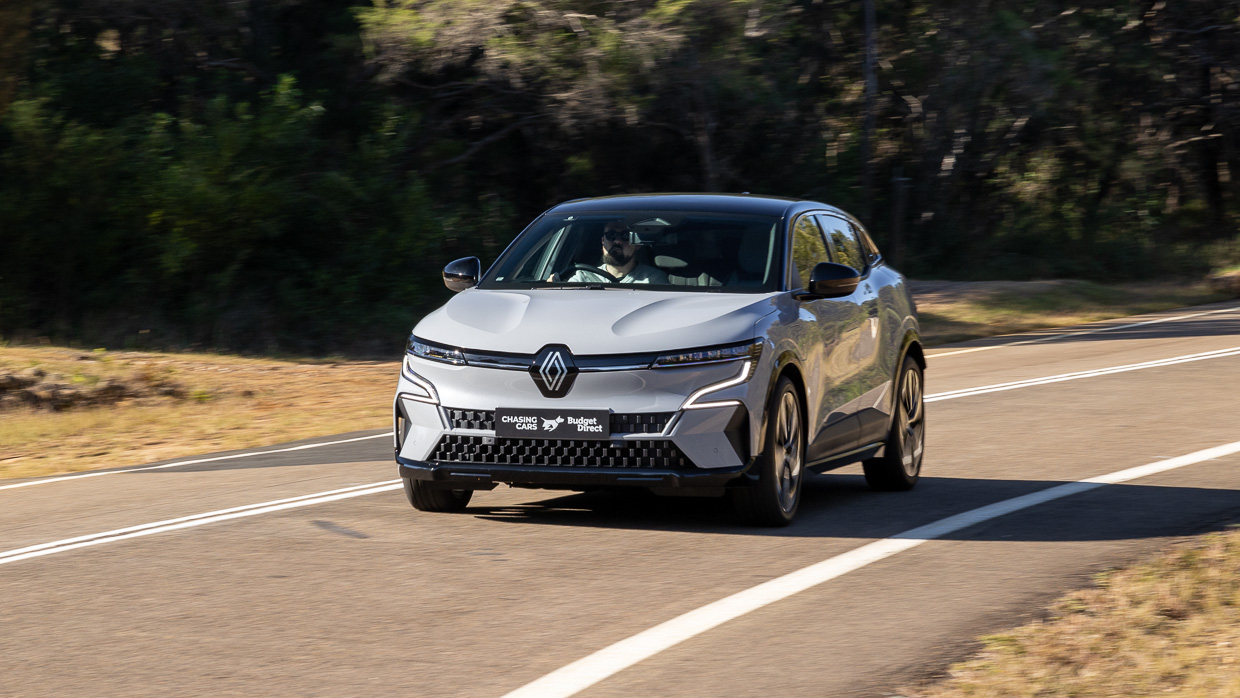
This is mainly the fault of the huge 20-inch wheels with low-profile tyres. The package doesn’t deal well with soaking up harder elements like expansion joints, potholes and concrete road pieces. It’s jarring at times, even crashy.
But the sense that the underlying ride is actually fairly pliant makes us quite interested in the British base model, which swaps the gorgeous-looking 20s for much more pragmatic 18s. We’d wager that this variant is quite a bit more comfortable indeed.
The Megane E-Tech’s exterior design genuinely wows – looking much like a concept car straight from the motor show floor – while the cabin achieves on a more modest scale.
Renault has avoided the use of leather globally in the Megane E-Tech, so this is a cabin fitted out with a classy blend of more sustainable and natural materials. These lend both warmth and feeling of expensiveness (probably beyond actual costs) to the interior, especially the light grey textile seats.
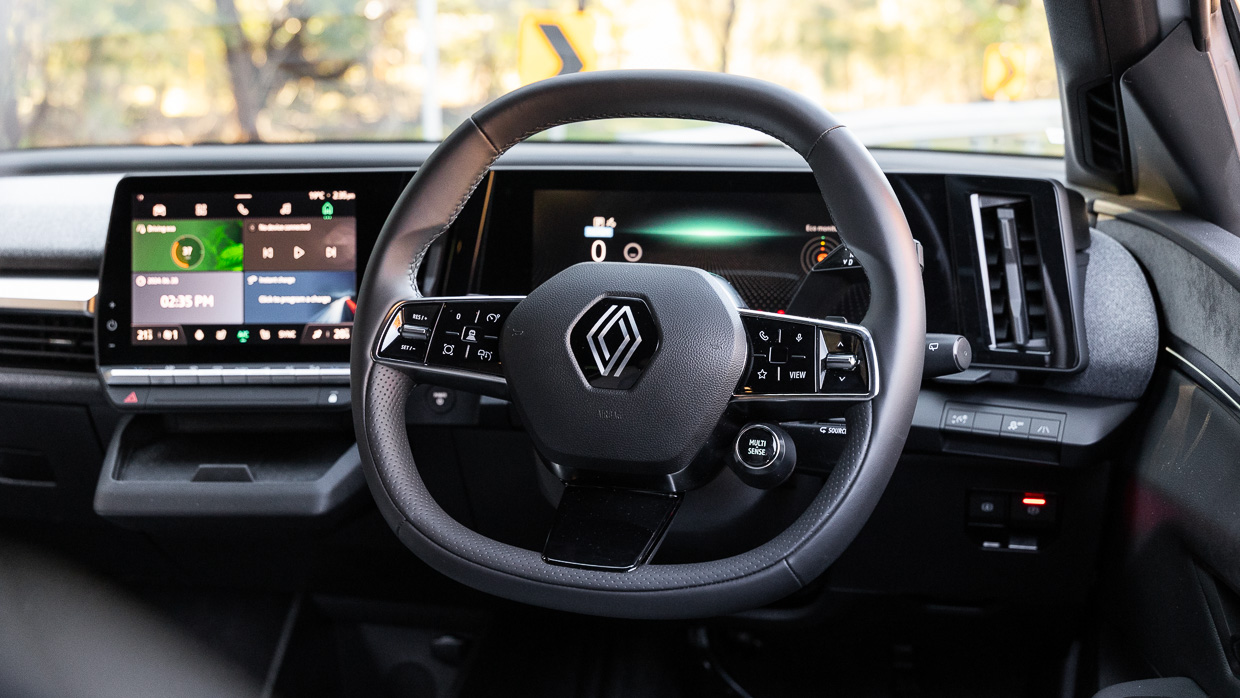
The upholstery won’t clean up as easily as the charcoal vinyl or leather, but those riding in the Megane will think it’s a rung or two more premium than it is. In truth, this is a mainstream crossover, albeit one where the designers have achieved a great deal without making the car too expensive
Still, much like in the Cupra Born, which achieves a similar feat inside, you don’t have to look too far in the Megane to find clues that it is, in fact, built to a price. The hard door tops are a giveaway, though the artificial suede inserts sitting one level lower are elegant.
While it’s attractive inside, our beef with the interior of the Megane E-Tech are precisely the seats. They’re superficially plush, but they lack thigh support for longer-legged drivers.
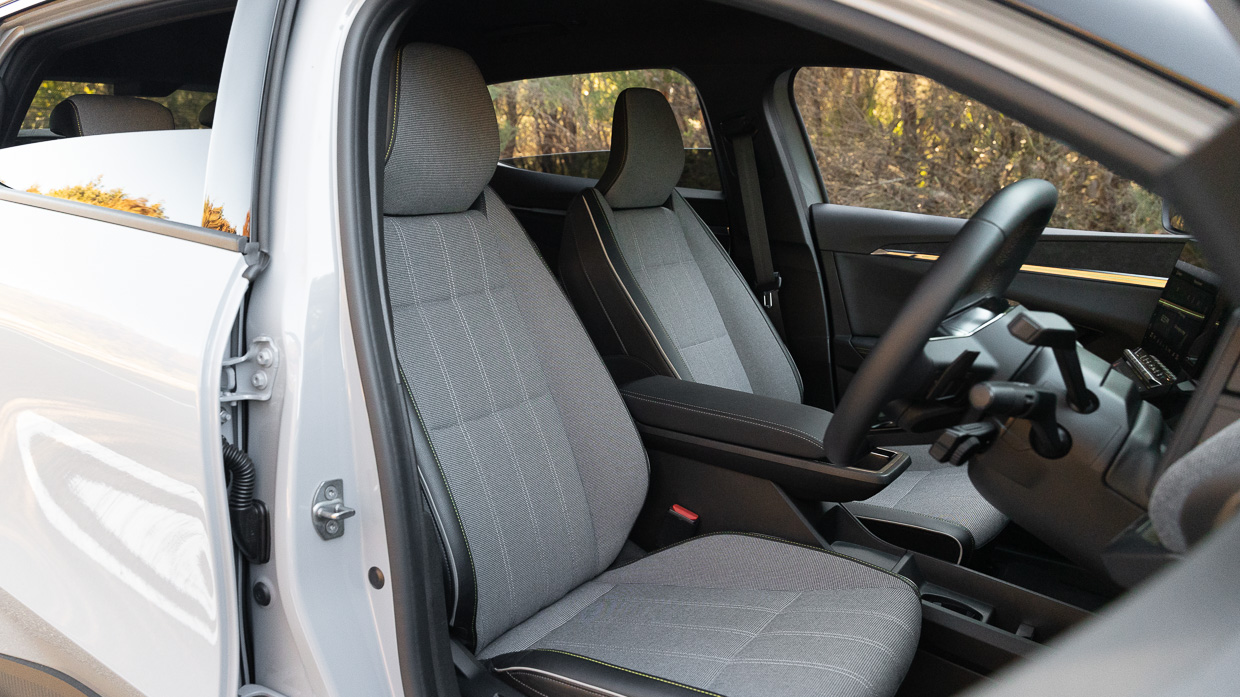
The problem exists because the front seats are manually-adjustable, they lack thigh angle tilt, but also because the fixed base is incredibly flat. As a result, your legs ‘float’ above the seat.
This is a shame because the rest of the ergonomics are actually pretty good.
We were nearly fooled by the fake leather on the steering wheel, and the fetching D-shaped tiller falls comfortably to hand. Both displays are bright and legible, while Renault has sympathetically retained hard buttons for fan speed, temperature and some other climate controls.
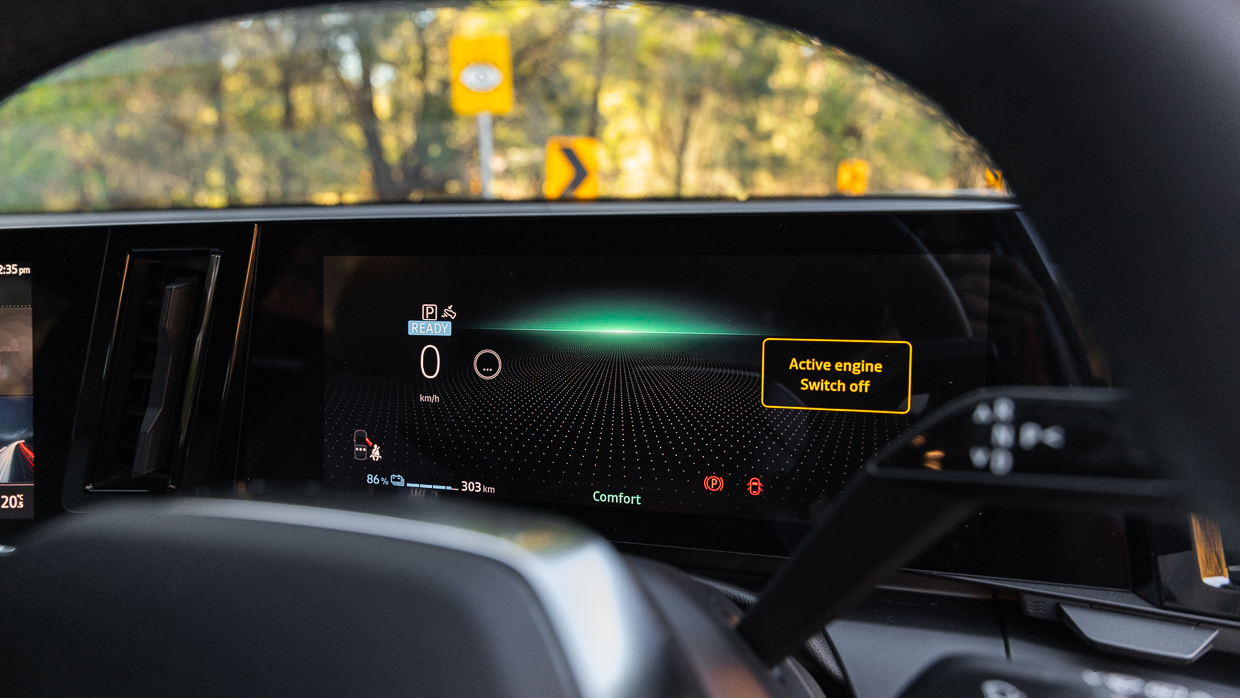
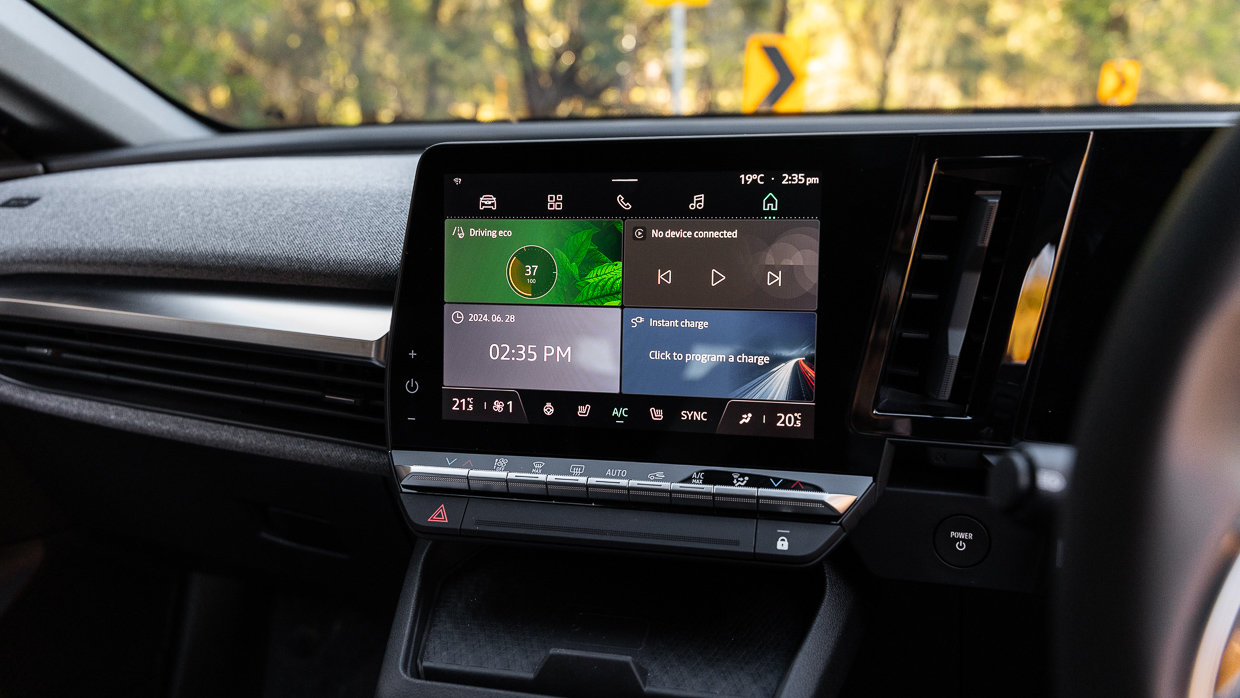
We revealed earlier in this review that the Australia-specification Megane E-Tech skimps on connectivity and infotainment. As a result, locals are lumped with Renault’s more dated Open R software, blending a small(ish) 9.0-inch touchscreen with a bigger 12.3-inch driver’s cluster.
The mix works…fine, but the lack of native navigation (or any networked features) means Australia’s ‘Meg’ is a generation behind the Euro version, and less competitive against EVs that offer an app and over-the-air updates.
Middle- and top-spec Meganes in Europe pack in more modern Google-driven infotainment with integrated Google Maps (with EV charging stop suggestions and battery pre-heating), not to mention an app and internet-driven software updates.
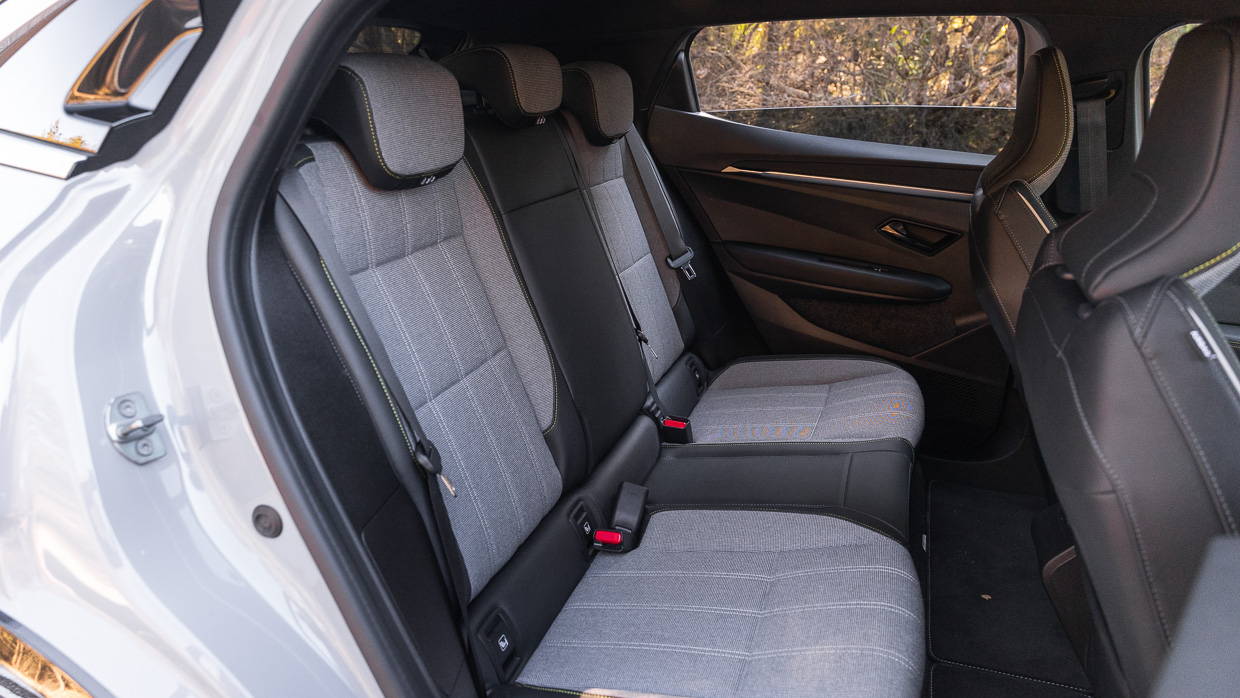
At least Renault Australia has succeeded in giving buyers wireless Apple CarPlay and wireless Android Auto (unlike Cupra, who had to pull out both wireless smartphone mirroring and connectivity from their similarly-sized, similarly-priced Born).
Packaging is a major upside to the E-Tech’s cabin, however. With a fairly generous 2685mm wheelbase and the wheels pushed to the corners, plenty of interior room is liberated. Up front, this means a good deal of storage thanks in part to the flat floor.
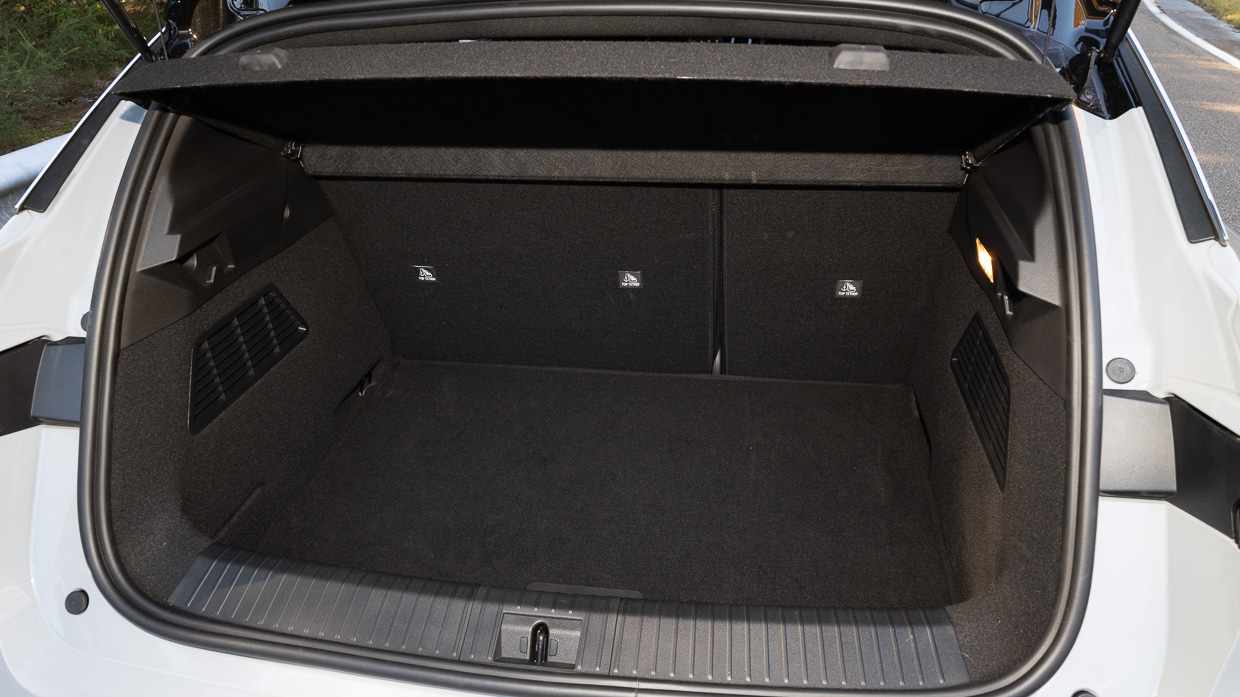
In the back, it makes for surprising space for a vehicle measuring a diminutive 4200mm in length. Six-footers have sufficient headroom and legroom, though toe room is constricted by the low-set front seats (in their lowest position) and the skateboard positioning of the high-voltage battery.
Renault claims the boot measures 440L, apparently due to the impressive depth of the cargo area. The shortness of the car means it’s naturally not a particularly long boot but you will still get a couple of suitcases in there with some under-floor storage for charging cables (and the tyre inflator kit). There’s no frunk, either.
Yes. The Megane E-Tech has a five-star crash and safety rating issued by ANCAP, which interpreted results generated from testing performed by Euro NCAP. The Renault’s five-star rating was issued in 2022, and will expire in December 2028.
Generally, the Megane’s scores were very high indeed, at least for the people in the car:
The Megane was tested against 2022 protocols, which were a bit more lenient in the safety assist tech department than the ones which kicked in later, in 2023.
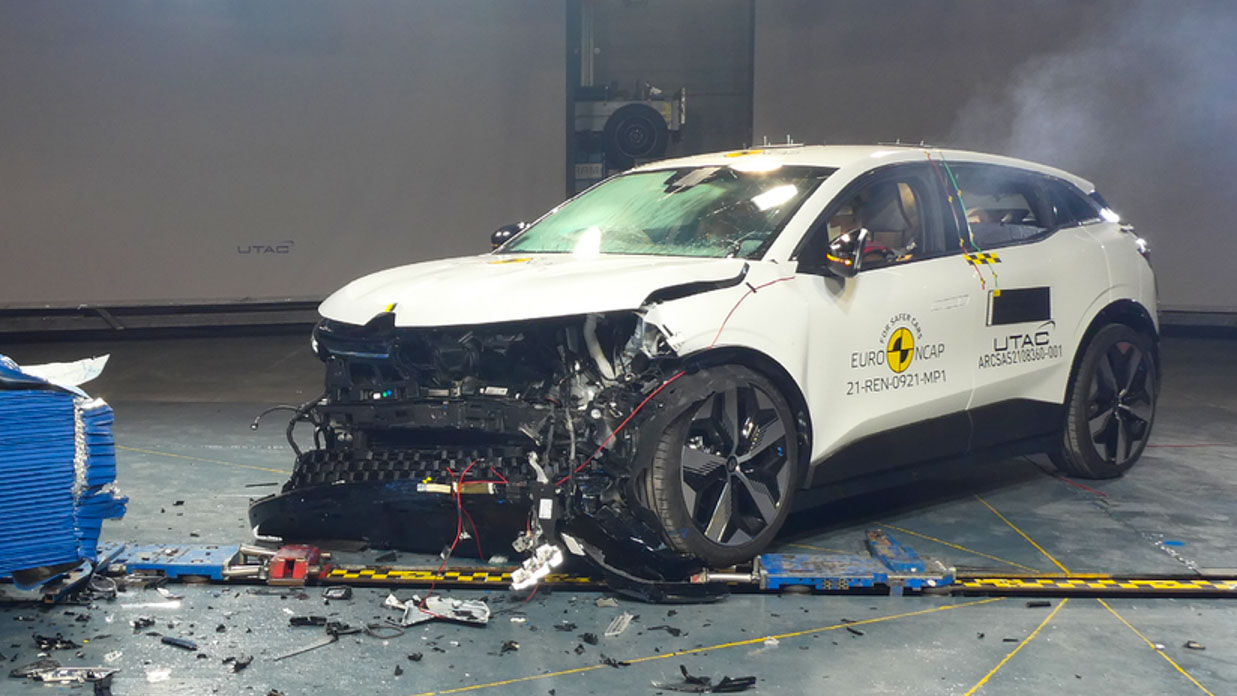
Standard safety technology fitted to the Australian-specification Megane E-Tech EV60 Techno includes:
Tuning was generally hands-off and subtle across our test. The Megane mostly remembers your safety settings when you turn the car off (and then back on), including whether the driver wants lane keeping intervention or not.
A degree of lane exit mitigation is always on, but strong assist can remain off, which was our preference.
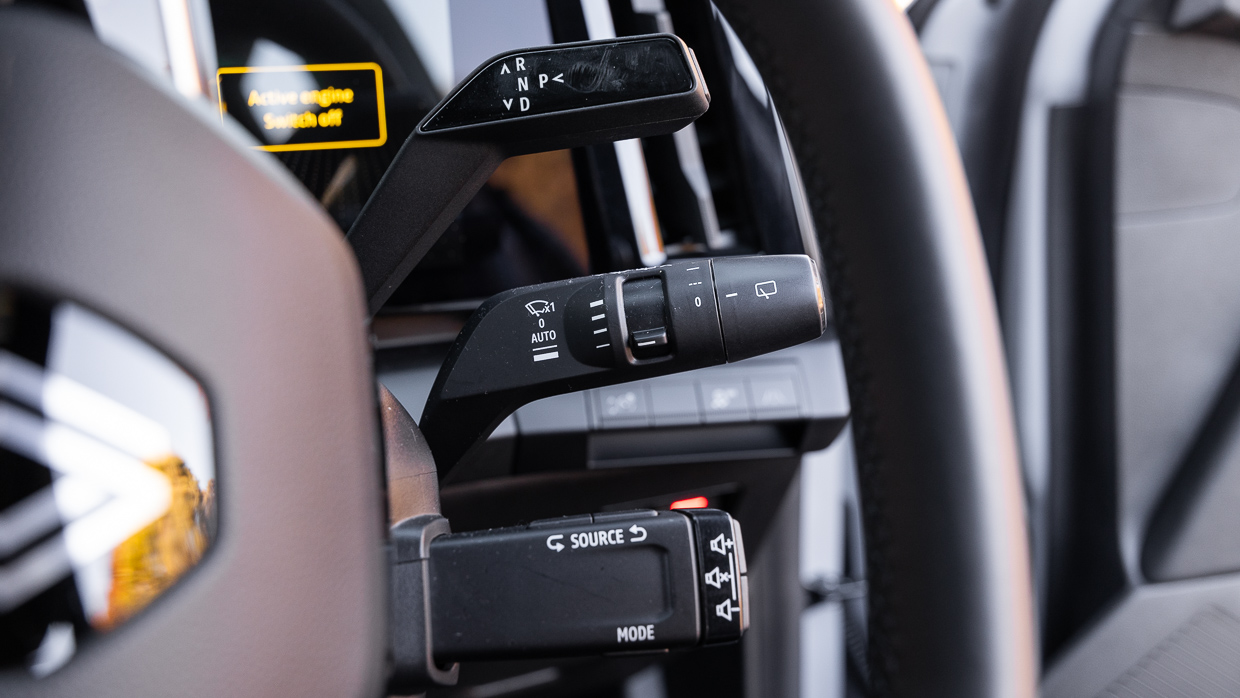
We’re glad the Megane does not have an audible speed limit warning system because we found the accuracy of the traffic sign recognition program to be quite poor, displaying the wrong speed limit on a number of occasions.
While it is a small car, at this price, a 360-degree camera would be appreciated. The Megane only has a reversing camera.
Further, the rear visibility is poor: Renault has attempted to mitigate the problem by way of a digital rear view mirror, but the feed is quickly obscured by water and road grime so as to become nearly useless.
Running costs for the Megane are reasonable for an EV and low compared to equivalent combustion vehicles. It isn’t too dear to service, but its main ownership drawcard is that it’s pretty efficient.
Beneath the cabin in a skateboard layout sits a 60.0kWh (usable) nickel manganese cobalt (NMC) lithium-ion battery which can be charged at up to 7.4kW AC (22kW in other markets), or at peak speeds of 130kW (DC).
In our testing, the Megane consumed:
Those results are liveable enough but nothing to write home about – the Polestar 2, Tesla Model 3 and Cupra Born are all more efficient in our experience. The Megane isn’t a particularly long-range vehicle but for most drivers it will be absolutely liveable for most purposes.
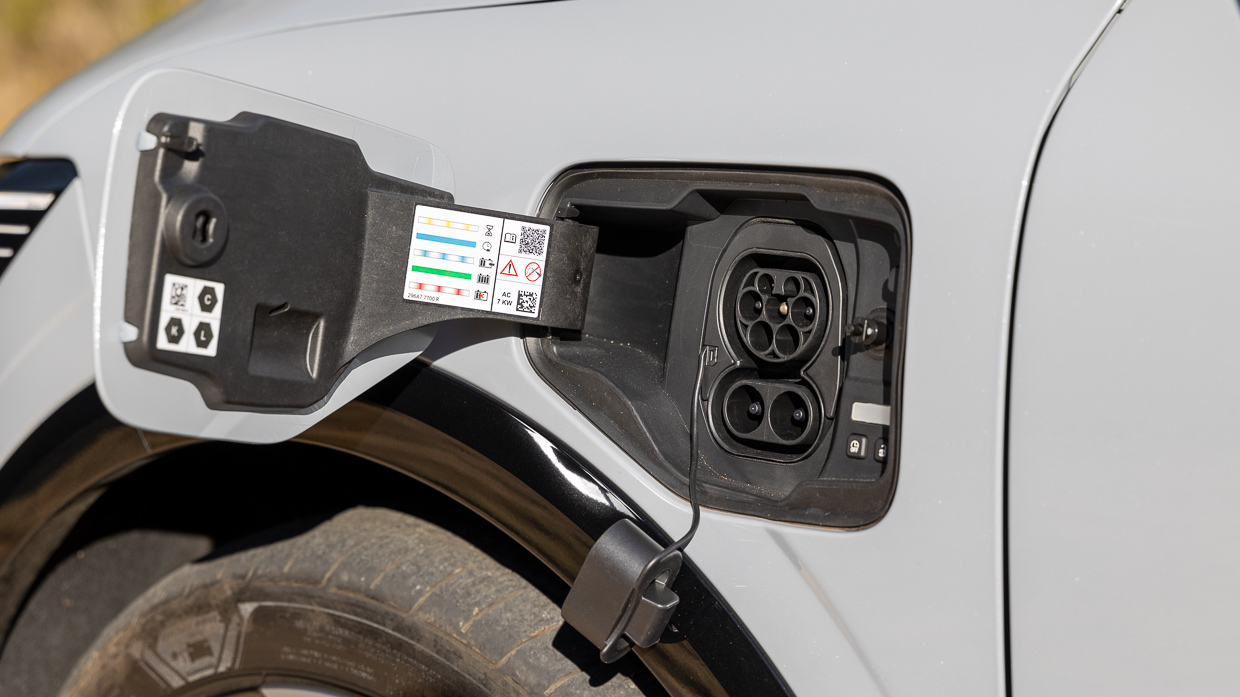
Servicing costs are $1588 for five years/150,000km with generous 30,000km limits between visits – yet Renault insists you maintain the Megane annually, where most EVs let you get away with 24-month spacing.
Of more concern is the Megane E-Tech’s warranty: at five years/100,000km, it is simply not good enough. The Australian standard is five years/unlimited kilometres, so the mileage limit stands out against virtually any rival – except Tesla, which is even meaner at four years/80,000km!
The Megane E-Tech’s battery warranty is, however, the standard eight years/160,000km.
In more than a few ways, the Renault Megane E-Tech is a beguiling and charming car. It looks fantastic to our eyes and its designers have delivered on the promise of a futuristic, yet proportionate, French EV. The interior is nearly as chic, filled with light and lush sustainable materials.
To drive, the Megane reinterprets Renault’s typical dynamic high notes for the age of electrification.
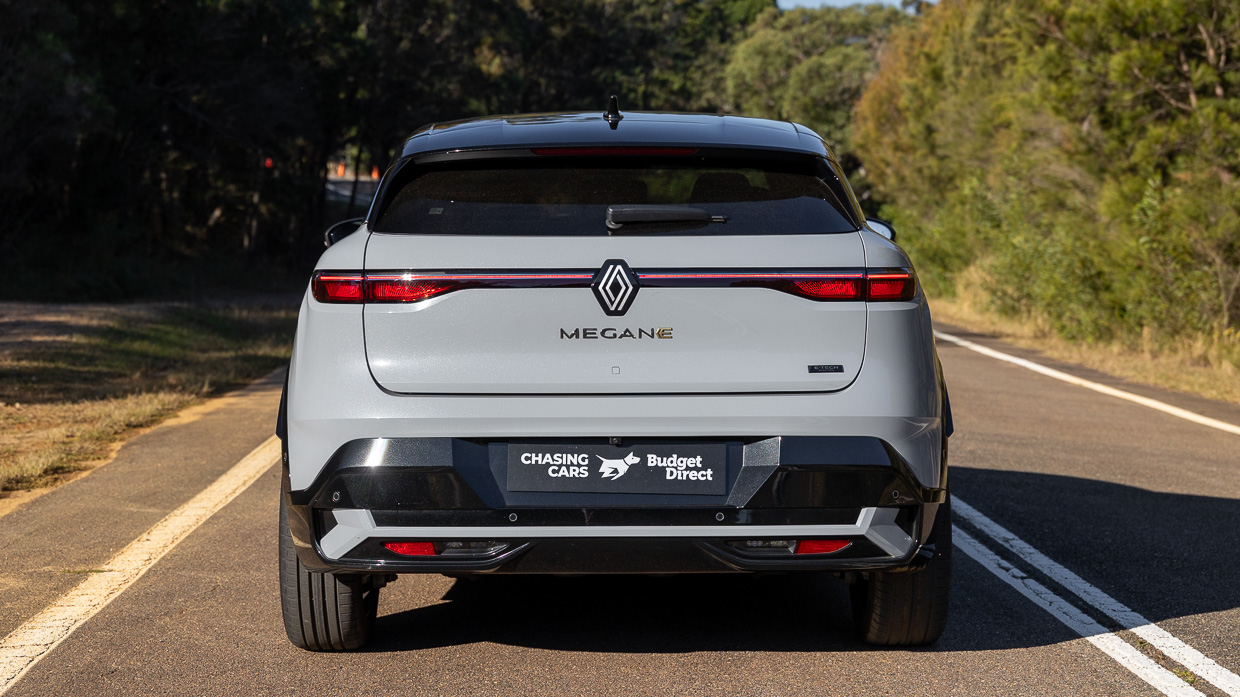
Delivering a relatively roomy, reasonably well equipped crossover with a 60kWh battery at under 1650kg is worthy of our praise, and the E-Tech drives with the zest and zeal long associated with the Megane name.
Yet Australians are asked to put up with a shorter equipment list than their peers in Europe, with rather rude cuts made to charging speed, connectivity and infotainment.
The Megane might have had a $10,000 price cut, but sixty-large is still premium money, and local buyers deserve access to the full-specification vehicle at this sort of ticket.
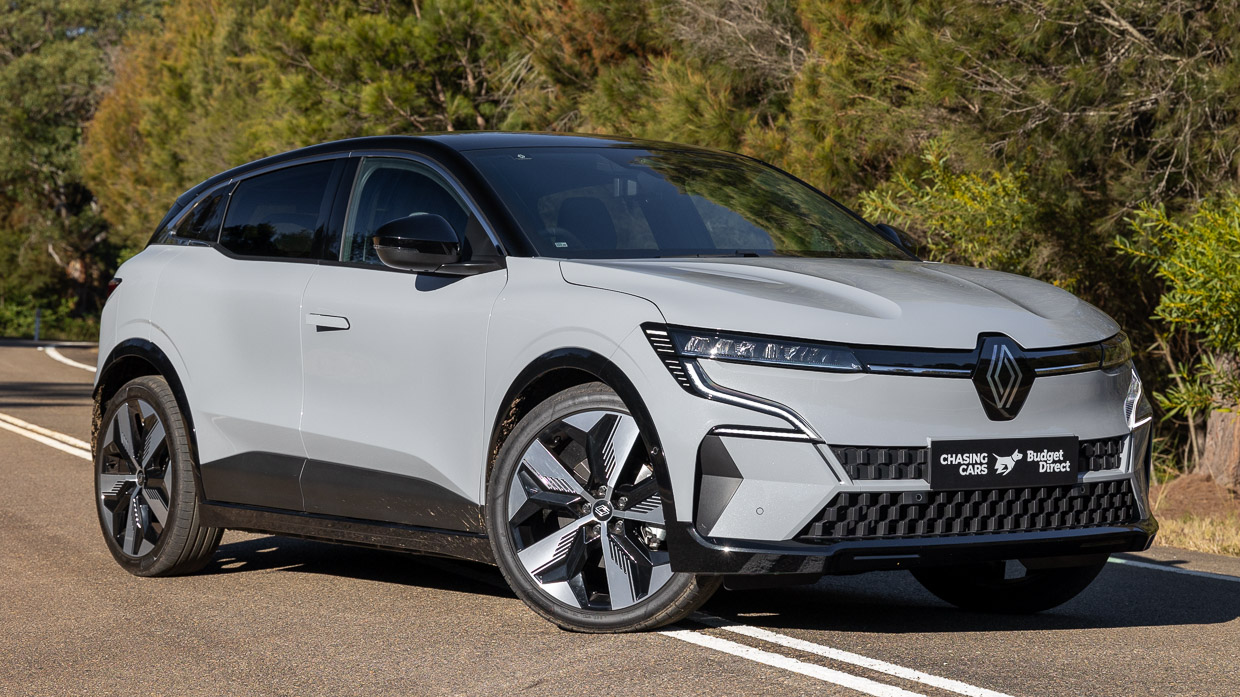
At sixty grand, the Renault offers plenty of flair and sophistication, if not a full equipment list. But if it reverts to its original seventy-grand level, it’s simply overpriced.
But if the ‘new’ price point is maintained, we recommend a test drive if the aesthetics and zesty, hot hatch-esque dynamics appeal to you.
If you’re a pragmatic buyer, though, a Model 3 would probably make considerably more sense. We suspect, however, that if you’re this deep into Renault EV research, you probably don’t want a Tesla in the first place.
Key specs (as tested)
About Chasing cars
Chasing Cars reviews are 100% independent.
Because we are powered by Budget Direct Insurance, we don’t receive advertising or sales revenue from car manufacturers.
We’re truly independent – giving you Australia’s best car reviews.
The estimate provided does not take into account your personal circumstances but is intended to give a general indication of the cost of insurance, in order to obtain a complete quote, please visit www.budgetdirect.com.au. Estimate includes 15%^ online discount.
^Conditions Apply
Budget Direct Insurance arranged by Auto & General Services Pty Ltd ACN 003 617 909(AGS) AFSL 241 411, for and on behalf of the insurer, Auto & General Insurance Company Limited(ABN 42 111 586 353, AFSL 285 571).Because we don’t know your financial needs, we can’t advise you if this insurance will suit you. You should consider your needs and the Product Disclosure Statement before making a decision to buy insurance. Terms and conditions apply.
Indicative quote based on assumptions including postcode , 40 year old male with no offences, licence suspensions or claims in the last 5 years, a NCD Rating 1 and no younger drivers listed. White car, driven up to 10,000kms a year, unfinanced, with no modifications, factory options and/or non-standard accessories, private use only and garaged at night.
^Online Discounts Terms & Conditions
1. Discounts apply to the premium paid for a new Budget Direct Gold Comprehensive Car Insurance, Third Party Property Only or Third Party Property, Fire & Theft Insurance policy initiated online on or after 29 March 2017. Discounts do not apply to optional Roadside Assistance.
2. Discounts do not apply to any renewal offer of insurance.
3. Discounts only apply to the insurance portion of the premium. Discounts are applied before government charges, taxes, levies and fees, including instalment processing fees (as applicable). The full extent of discounts may therefore be impacted.
4. We reserve the right to change the offer without notice.